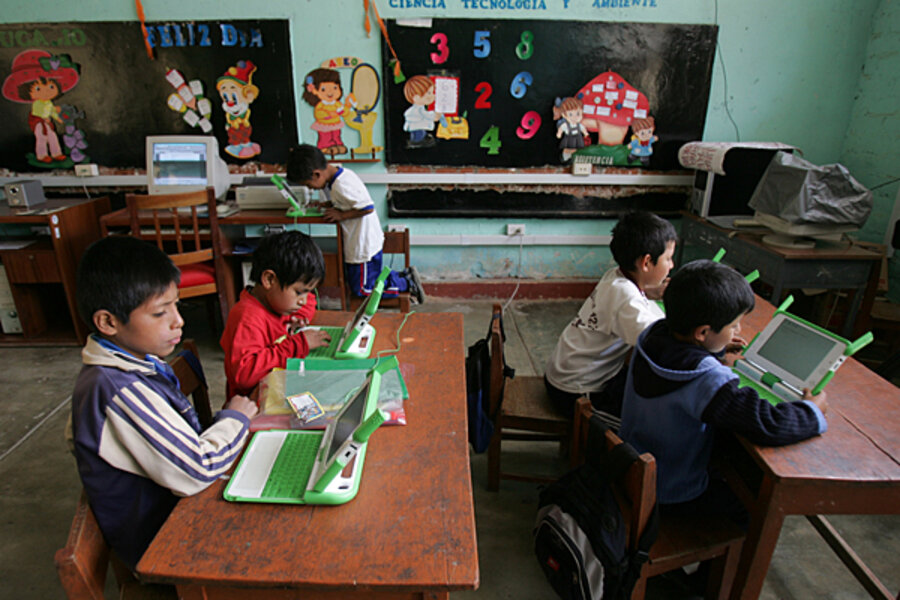Logistics unhinge Peru's laptop dreams
Loading...
| Lacachi, Peru
When Peru decided to invest in the One Laptop Per Child (OLPC) program in 2007, the government knew it couldn’t afford to rush out and buy a laptop for every child all at once.
“So we said, ‘Let’s begin with the poorest and the most remote,’” says Oscar Becerra, the former Education Ministry official who headed up the program.
Many of the small white and lime green XO laptops ended up in impoverished urban schools. Tens of thousands of the computers also ended up in the most isolated parts of the country; places like Amazon outposts that take days to reach by boat, and high-altitude Andean villages.
And though the program has good intentions – the idea of OLPC is to increase access to technology, and with it, quality of education – results have been mixed in Peru. Student performance has improved in some academic areas like verbal skills, but in many cases, especially in rural villages, the laptops seem more symbolic than practical.
“I think the government at the time bought the whole OLPC story; that these computers in the hands of kids would be a valuable tool in and of themselves. It was almost like they believed they should just go toss them out of helicopters,” says Sandro Marcone, the government official currently in charge of the program.
Internet 'still just a dream'
OLPC is an international NGO that works in 46 countries, with the goal of providing low-cost laptops to children in the developing world. When it was founded in 2005, OLPC concept of bringing inexpensive laptops to all corners of the globe was a hit in the international development world.
In the Peruvian countryside, poor roads, wild terrain, and a lack of electricity pose big challenges to OLPC. Repairs are hard to come by, and some families trek hours to charge batteries.
The town of Lacachi is one of the remote mountain villages that received the simple laptop computers. It sits at over thirteen thousand feet, near the shores of Lake Titicaca, and is several days’ travel from Lima. It’s a quiet shuffle of mud brick homes and worn footpaths, in the middle of a landscape that’s one part dry plain, one part mountain horizon, and three parts wide, baby blue sky. Most people here are Aymara subsistence farmers, who grow potatoes, herd sheep and llamas, and live below the poverty line.
The town still lacks basic services, like potable water, which should happen later this year. Electricity arrived a few years ago, but half the houses still don’t have it. For the ones that do, outages are common. The Internet is still just a dream, and schoolteacher Eleazar Pacho says it makes trying to integrate laptops excruciating.
“Just try to imagine if you had a tablet or a laptop with no Internet connection. I have no idea how useful that would be for you,” Mr. Pacho says. “But it seems to me that a laptop without Internet is not good for much.”
Pacho does his best to adapt classroom exercises to use the XO’s basic drawing and photo programs. He’s young, and lives in the small city of Puno, a few hours away, where he has regular Internet access. Pacho’s familiar with computers; but he admits that many older teachers, or those who live full-time in rural areas, don’t know how to use them.
There are other challenges, too. Government officials say that some parents didn’t understand the idea behind the computers, and sold them. Others were lost, or broken; in Pacho’s classroom at least a quarter are unusable. Many kids make due with ones missing keys, or that have damaged screens. Then there’s the issue of charging them; although Lacachi gets intermittent power, more remote towns are sometimes hours away from electricity.
Jeff Patzer, a software engineer in San Francisco, traveled to Peru and worked with the government to evaluate the program. He says he met some parents who would take turns gathering all the kids’ laptops, strapping them onto a mule, and trekking all morning to a town with electricity, just so the batteries would get a three-hour charge. Mr. Patzer also says he did software updates manually, since there was no Internet where he traveled, and that it was a "logistical nightmare".
“You can’t just give someone a tool and expect that they’re going to figure it out and become a master at it. That’s just not how it works,” he says.
'Learn about everything'
Marcone, who inherited the OLPC program from the past administration, voices many of the same concerns as Patzer, but admits there has been some success, too. An Inter-American Development Bank study found Peruvian kids with laptops were six months ahead of their peers in reasoning and verbal ability. The study, however, found no improvement in critical areas like math and language, classroom instruction, or reading habits.
All told, the Peruvian government has spent $200 million on about 800,000 laptops, and Marcone says that now, whether he thinks it was a good idea or not, it’s his responsibility to make the program work. He believes success will ultimately lie in local communities adopting the laptops as their own and better connectivity.
Ten-year-old Liliana Condori is a student in Lacachi. She’s had her laptop for almost three years; during that time, she spent one hour on the Internet, on a field trip to the city that her teacher, Eleazar Pacho, organized specifically for that purpose. She’s hungry for more.
“I want to use the Internet to learn about everything. I want see the world, know about the planet, and know what’s happening everywhere,” Liliana says. As she talked, she played with her long braid, eyes flicking toward the window. Outside, the view was of a dirt soccer pitch, a dun-colored mountain, and acres of sky.







